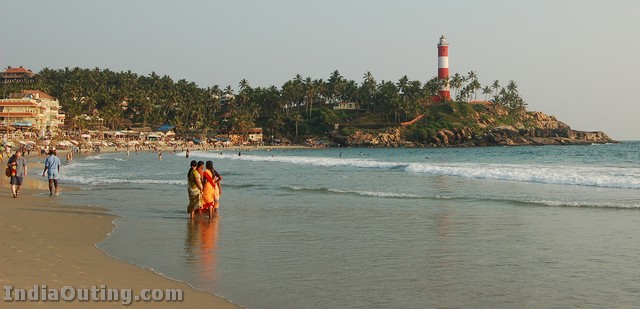Megalithic structures
Posted on Sunday, July 26, 2009 by CASANOVA | 0 comments
The truly mysterious thing about the ancients is, how were they able to create such enormous things? They did not have the technology
needed to efficiently make them. Stonehenge is a good example.. A bigger one is the Great Pyramid in Giza, or the pyramids themselves.
Sometimes, even their purpose is unclear (Stonehenge) , while other times, the structures in question are mysterious and seemingly
supernatural (the pyramids). A megalith (I know, sounds like something from Di-Gata Defenders), a giant rock, is used most of the time,
especially in the case of Stonehenge and the Carnac stones. Still, there are a few megalithic structures that are not mysterious
(like Great Zimbabwe), but mostly it seems impossible that the ancients made these things themselves. Now, many would like
to think aliens helped them. Yet even scientists say queerer things. They suggest that there may have been a lost ancient civilization
that was extremely advanced, and they may have given later civilizations the knowledge to build such things. Yet there is no
substantial evidence of either.. Other examples: Easter Island Heads, Pyramid of the Sun (in Mesoamerica) ,
other pyramids in central and south America, Colossus of Rhodes.
Nazca Lines
Posted on Sunday, July 26, 2009 by CASANOVA | 0 comments
They look as if they were drawn by some giant hand two thousand years ago. And the strange thing is, they can only be seen from the air.
So how did the ancient Nazcans draw them? Researchers say they could have created hot air balloon or kites to fly and view their work.
Indeed, an experiment was carried out and it proved that the Nazcans could have made a working balloon. The symbols themselves are of animals
and plants. Yet some are long strips of land without any direct meaning.. A writer named Erich Von Daniken believed that these were
landing strips for alien spacecraft, and that aliens could have drawn them. They may also be for contacting these aliens. Maria Reiche,
an astronomer, says that these lines may be used as a calendar, or to keep track of the stars and planets. There is a monkey drawing
that has a coiled tail that looks similar to the orbital lines of our solar system. There are even more obscure theories that suggest
that there were giant people 2,000 years ago. Yet, they are still a mystery.
2012
Posted on Sunday, July 26, 2009 by CASANOVA | 0 comments
from Central America, had a special calendar that was mind-blowingly accurate. And it predicted that the end of the human life
cycle was on December 21st, 2012, the winter solstice. The Mayans were also good at math and astrology(they accurately
predicted an eclipse that occurred hundred of years later). So people are guessing that they were right about the end of the world thing,
too. Something else that has gotten scientists curious is that there are some major astronomical things happening in 2012.
Apart from the occasional eclipse and comet, the entire solar system is supposed to pass through the center of our galaxy, s
omething that happens only once every 26,000 years. And, there’s a risk of our planet’s poles switching.
Sounds crazy, but scientists say this has already happened. Also, the Indian calendar, the Kali Yuga, ends at about the same time.
Coincidence? I think not
Panspermia
Posted on Sunday, July 26, 2009 by CASANOVA | 0 comments
Yet did microscopic organisms just pop out of nowhere? One hypothesis is panspermia, which suggests that ‘seeds of life’ exist everywhere
around the universe, and that life on earth started when these ‘seeds’ came here, probably by a meteor. It also suggests that these
seeds are taken to other habitable places in the universe. Something similar to this is exo-genesis. It suggests that life was brought to
earth those billions of years ago, however it does not say that life is also taken to other habitable places. Some people
believe aliens brought life to our planet, as suggested by the theories of Erich Von Daniken. Although some are sceptical as to how
life could exist in space and get carried to other planets, there is substantial evidence that certain life forms, like spores and
certain types of bacteria can actually exist in space, perhaps in a dormant state.
Placebo Effect
Posted on Sunday, July 26, 2009 by CASANOVA | 0 comments
Federer's wife gives birth to twins
Posted on Friday, July 24, 2009 by CASANOVA | 0 comments

Roger Federer's wife Mirka has given birth to twin girls, the world number one announced on his website.
The 15-times Grand Slam winner said Charlene Riva and Myla Rose had been born on Thursday in Switzerland.
"This is the greatest day of our lives," Federer said on the website. "Mirka, Myla and Charlene are all healthy and doing very well."
The last time a mother won a singles Grand Slam crown was in 1980 when Australian Evonne Goolagong triumphed at Wimbledon.
Since then, only eight men have captured a major after embracing the joys of fatherhood.
While four -- Pat Cash, Andres Gomez, Petr Korda and Albert Costa -- were one-slam wonders, multiple champions Boris Becker, Yevgeny Kafelnikov and Andre Agassi managed to add just one further slam to their haul after becoming parents.
Jimmy Connors was the only singles player to successfully combine family life with playing on the tour in that time, winning three of his eight Majors after the birth of his son Brett in August 1979.
For the likes of John McEnroe, Ivan Lendl and Stefan Edberg, the titles dried up as soon as they gingerly cradled the new additions to their families.
Tennis fathers have won only 10 of the last 115 Grand Slam titles.
"(Fatherhood) changes (your) life dramatically," explained Becker, who won the 1996 Australian Open after the birth of his first son Noah.
"It would be more difficult to focus on one thing alone because your main focus is for your child and your wife, and tennis becomes secondary. That's a fact."
Reuters
Bikini Contest
Posted on Saturday, July 18, 2009 by CASANOVA | 0 comments
A bikini or two piece is a women's swimsuit with two parts, one covering the breasts (optionally in the case of the monokini), the other the groin (and optionally the buttocks), leaving an uncovered area between the two (optionally in the case of the Tankini). It is often worn in hot weather or while swimming. The shapes of both parts of a bikini resemble women's underwear, and the lower part can range from revealing thong or g-string to briefs and modest square-cut shorts. Merriam–Webster's Collegiate Dictionary (11th edition) describes the bikini as "a woman's scanty two-piece bathing suit", "a man's brief swimsuit" and "a man's or woman's low-cut briefs".
The bikini, which shocked when it appeared on French beaches in 1947, dates back to antiquity, in Çatalhöyük[1] and the Greco-Roman world.[2] The modern bikini was invented by French engineer Louis Réard in 1946. He named it after Bikini Atoll in the Pacific, the site of the Operation Crossroads nuclear weapon test on July 1, 1946. The reasoning was that the burst of excitement created by it would be like a nuclear device. The monokini, a bikini variant, is a back formation from bikini, interpreting the first syllable as the Latin prefix bi- meaning "two" or "doubled", and substituting for it mono- meaning "one".[3] Jacques Heim called his bikini precursor the Atome, named for its size, and Louis Réard claimed to have "split the Atome" to make it smaller.
From a 1949 Los Angeles Times report: "The bathing beauty queen—blond Bebe Shopp, 18, of Hopkins, Minn.—got an enthusiastic welcome in Paris, but she said she hasn't changed her mind about French swim suits. ... 'I don't approve of Bikini suits for American girls,' Bebe told her French interviewers. 'The French girls can wear them if they want to, but I still don't approve of them on American girls."[4]
The bikini is perhaps the most popular female beachwear around the globe, according to French fashion historian Olivier Saillard due to "the power of women, and not the power of fashion". As he explains, "The emancipation of swimwear has always been linked to the emancipation of women."[5] By the mid 2000s bikinis had become a US$811 million business annually, according to the NPD Group, a consumer and retail information company.[6] The bikini has boosted spin-off services like bikini waxing and the sun tanning industries.
Street Bath
Posted on Saturday, July 18, 2009 by CASANOVA | 0 comments
Marshall Street Bath's heritage is notable; most impressive are its ancient baths. The first public baths were built on the site by the Vestry of St. James in 1850. The present building, then known as The Westminster Public Baths, was started in 1928 and completed in 1931. Public funds financed the construction for the health and well being of local people.
The main pool is lined with white Sicilian marble and this marble and Swedish green marble are used on the walls at either end. The bronze fountain in a niche at the shallow end, depicting a merchild with two dolphins, is by Walter Gilbert.
Behind the pool is a smaller pool, the 'second class bath' which measures 70ft x 30ft'. It has a barrel vaulted roof. Initially, the complex also included a child's welfare centre, a public laundry and public bathing facilities, among other things.
Marshall Street baths are owned by Westminster City Council and were closed by the Council in 1997. There are currently plans to refurbish the site and re-open the pool as part of a public leisure centre in early 2009.
















Michael Joseph Jackson-Rare Pictures
Posted on Friday, July 10, 2009 by CASANOVA | 0 comments
Michael Joseph Jackson (August 29, 1958 – June 25, 2009), often dubbed the "King of Pop," was an American recording artist, widely regarded as one of the greatest entertainers who ever lived. With his trademark black fedora and single, sequinned glove, his unique contributions to music and dance, along with a highly publicized personal life, made him a central part of popular culture around the world for four decades.
One of the few artists to have been inducted into the Rock and Roll Hall of Fame twice, his achievements included multiple Guinness World Records—including the "Most Successful Entertainer of All Time"—13 Grammy Awards, 13 number one singles, and the sale of over 750 million records. He was also a notable philanthropist, donating millions of dollars to the 39 charities he supported, and raising more through his own Heal the World Foundation.
The seventh child of the Jackson family, he made his debut in 1968 as a member of The Jackson 5, beginning a solo career in 1971. His 1982 album Thriller remains the best-selling album of all time, with four others—Off the Wall (1979), Bad (1987), Dangerous (1991), and HIStory (1995)—among the best selling. He popularized several physically complicated dance moves, such as the robot and the moonwalk, now iconic. He is widely credited with having transformed the music video from a promotional tool into an art form, with videos such as Thriller, "Beat It" and "Billie Jean" making him the first African American to amass a strong crossover following on MTV, and others, such as "Black or White" and "Scream", ensuring his popularity well into the 1990s.
Jackson's personal life generated significant controversy. His changing appearance was noticed from the early 1980s, his skin appearing paler and his facial features becoming almost androgynous. He was accused in 1993 of child sexual abuse, and though no charges were brought, his health suffered when he started using painkillers to cope with the stress. He married twice and fathered three children, one of them with a surrogate mother, actions that triggered more speculation about his life. In 2005, he was tried and acquitted of different child molestation allegations, which provoked a further decline in his health. He died in Los Angeles on June 25, 2009, aged 50, after suffering a cardiac arrest. His memorial service was broadcast live around the world and attracted an audience of up to one billion people.[3]





Munnar-Know India-Part 4
Posted on Friday, July 10, 2009 by CASANOVA | 0 comments
Munnar
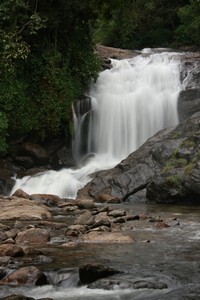 Munnar (Malayalam: മൂന്നാര്, Tamil: மூணார்) is a town located in Kerala state in the southern Western Ghats in South India. Munnar was a summer resort of British government in South India. It is 1600 m (5400 ft) above sea level. It is pronounced “Moon-aar” meaning “Three rivers” in Tamil and Malayalam. There are in fact three rivers - Madupetti, Nallathanni and Periavaru which flow through this town, but join some distance away from Munnar.
Munnar (Malayalam: മൂന്നാര്, Tamil: மூணார்) is a town located in Kerala state in the southern Western Ghats in South India. Munnar was a summer resort of British government in South India. It is 1600 m (5400 ft) above sea level. It is pronounced “Moon-aar” meaning “Three rivers” in Tamil and Malayalam. There are in fact three rivers - Madupetti, Nallathanni and Periavaru which flow through this town, but join some distance away from Munnar. The neelakurinji, a blue flower which blooms only every twelve years, is found in this region. It bloomed last in December 2006. Munnar also has the highest peak in South India, Anamudi, at 2695 m.
The tea plantations and holiday facilities make this a popular hill station in Kerala.
Altitude : 1600 Mts to 1800 Mts above sea level. Temperature : Min. 0c - Max. 25c. Clothing : Warm Clothes and Rain Gear. Tourist Season : August to March
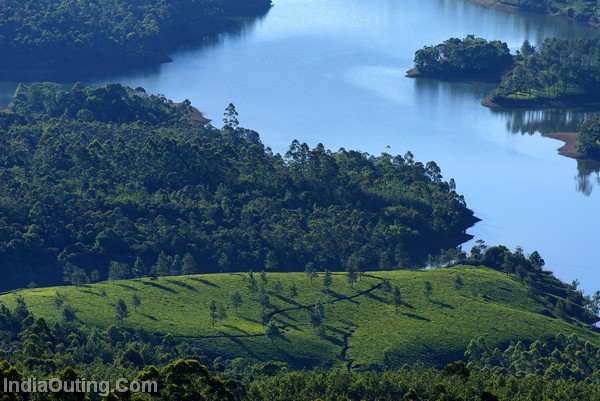
Kovalam-Know India-Part 3
Posted on Friday, July 10, 2009 by CASANOVA | 0 comments
Kovalam - Beach Town on the Arabian Sea
 Kovalam is famous for its beaches, among the most pristine in India. It is about 17 km from Thiruvananthapuram city, the capital of the southern state of Kerala in India. Kovalam is popular region comprising three beaches situated in the state of Kerala in the south of India. The southernmost, known as the Lighthouse Beach, is the most popular of the three. Many hotels, restaurants, lodges and shops are located here. It is frequented by outsiders who stay and enjoy Kovalam. The Northern most crescent is crowded on the weekends, is very popular with the locals, day-travelers, and passing-by tourist buses. Hawa Beach, is among one of the beaches in India where top-less sunbathing is tolerated and well appreciated by the locals, who come on the weekends to admire this view free of charge. The tourism department provides a vigilant life guard service on both Lighthouse and Hawa beach. Those expecting a replica of Goa will be pleasantly surprised by the more relaxed atmosphere,a bit more laid back,the food a touch softer and lighter.
Kovalam is famous for its beaches, among the most pristine in India. It is about 17 km from Thiruvananthapuram city, the capital of the southern state of Kerala in India. Kovalam is popular region comprising three beaches situated in the state of Kerala in the south of India. The southernmost, known as the Lighthouse Beach, is the most popular of the three. Many hotels, restaurants, lodges and shops are located here. It is frequented by outsiders who stay and enjoy Kovalam. The Northern most crescent is crowded on the weekends, is very popular with the locals, day-travelers, and passing-by tourist buses. Hawa Beach, is among one of the beaches in India where top-less sunbathing is tolerated and well appreciated by the locals, who come on the weekends to admire this view free of charge. The tourism department provides a vigilant life guard service on both Lighthouse and Hawa beach. Those expecting a replica of Goa will be pleasantly surprised by the more relaxed atmosphere,a bit more laid back,the food a touch softer and lighter. 

Get in
Kovalam is about 16 km (20 minutes in a taxi) from Trivandrum. Taxis can charge around 400-500 rupees to get to Kovalam. When asked where you want to go, say Hawa Beach, Leela Beach/Main Beach or Lighthouse Beach in Kovalam.
In an auto-rickshaw 250-300 rupees is a fair price, avoid going above 300 rupees. If in doubt ask to use the meter, but in reality they really don’t work at all. Advice being if they are trying to rip you off go to leave for another rickshaw and they will often back down and offer you a fair price, if not, get in a different rickshaw. Even if India is a cheap country, the prices for gasoline are international standard, so don’t expect super cheap private transportation. If you go by public bus from Trivandrum-East Fort to Kovalam Beach you only pay 8 Rps. for the half hour trip.
Buses to Trivandrum can also be caught from Kovalum Junction as well as Amabassador taxis and Autos to pretty much anywhere. Be very careful walking around the junction, especially at night, as there are no traffic lights (what’s new?!) and the street lighting is very minimal. The intersection can be busy.
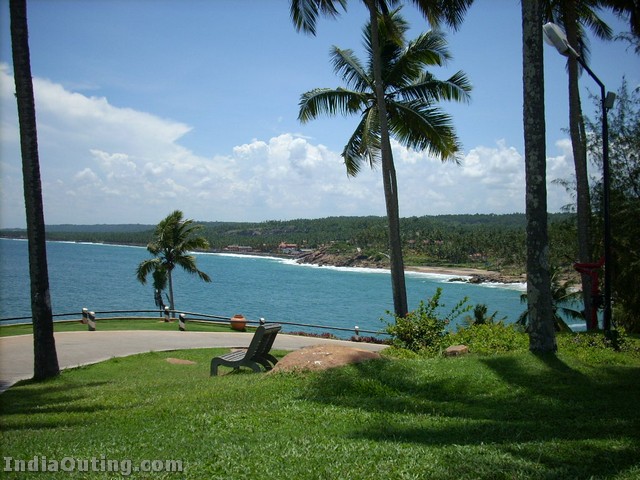

Get around
Tourist taxis are the most convenient way to travel around attractions, especially while travelling in a group. Most airports and railway stations have tourist taxi services that would take you anywhere you would want to go.
A more adventurous option is to get a bike on hire. The highway is a pleasure to drive on, with the cool breeze and coconut palms lined along the way. Once on the highway, drive north for the plains, drive south for the hills. Avoid driving through Thiruvananthapuram city, it’s congested. The old highway, also called MC road, is also good to drive on. The MC road can take you deep into the hills. Try out the throaty Enfield 350 CC bikes for a truly vintage experience, check your fuel levels before you leave.
Two wheelers do not have to pay the highway toll, simply ride through the side lane.
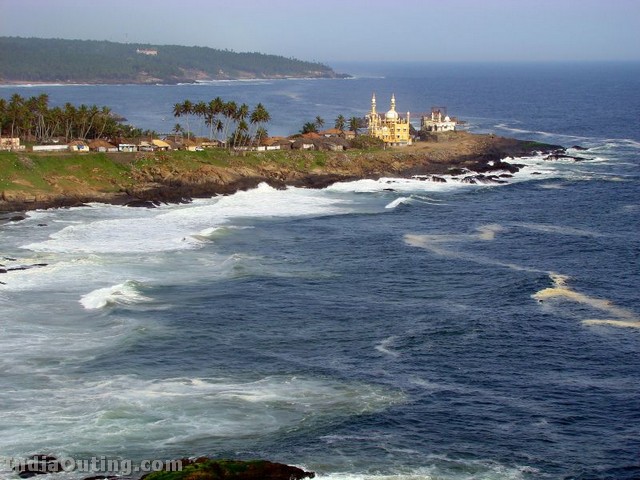

See
- Varkala Drive north on the highway for about an hour (55 km). It has a superb beach and cliff front and the usual tourist amenities. The quiet sandy beaches and large lakes of Paravur (65 km from Kovalam) are also close to Varkala and are hidden away. Paravur is a shared secret among those seeking a more peaceful getaway.
- Ponmudi - A nice semi-hill station located about 1 1/2 hours from Kovalam.
- Neyyar Dam ca 1,5 hours by local bus. Only worth to visit if you do not know what else to do. It is a water reservoir. No other curiosities except some crocodiles kept in cages. Better spend the time on the beach.
- Backwater Tours between Kovalam and Trivandrum there are backwater trips available that can be booked at Kovalam Beach itself. Small boats for 4-6 persons. A nice experience.
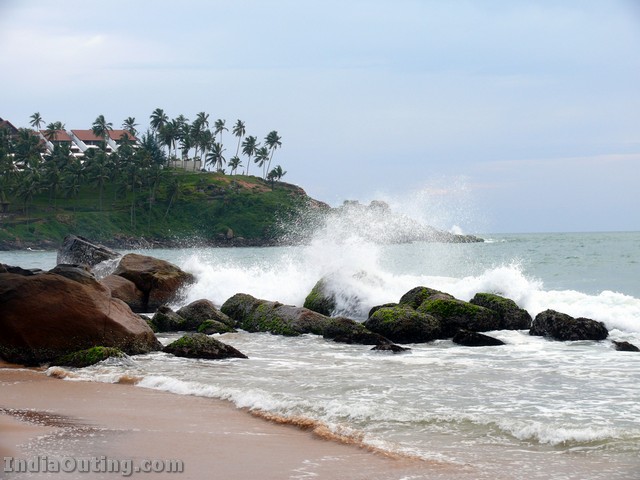
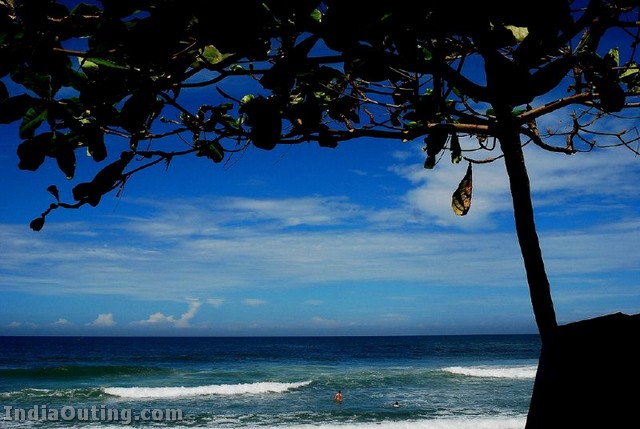
Do
- Surfing - Some fine waves from time to time (0.5 - 2 meters). You can hire surf boards and body boards on the beach from $6USD a day. Body boarding can be enjoyed by anyone. Surfing takes a bit more skill. It is wise to follow the life-guards’ instructions as there are some strong currents that can suddenly whisk the unwary out to sea.
